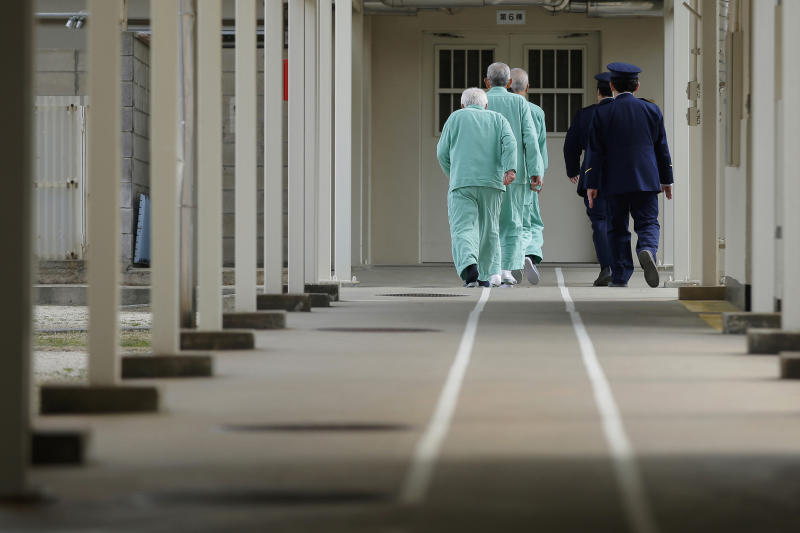Japan grapples with elderly crime wave among poor, lonely pensioners
Sign up now: Get insights on Asia's fast-moving developments

Prison guards escort inmates walking in single file along a marked pathway at Sasebo Prison in Sasebo, Nagasaki Prefecture, Japan.
PHOTO: BLOOMBERG
Follow topic:
TOKYO - Clad in all black like an ancient day ronin, a man scales high walls and squeezes into tight spaces in the dark of the night - but in the name of crime.
His agility eluded Osaka police over eight years, during which more than 29 million yen (S$345,690) was stolen from some 250 crimes.
But Mitsuaki Tanigawa, dubbed the 'Heisei ninja' - named after the current imperial era - is 74 and, by police accounts, is a doddering old man in the day.
His identity was finally revealed on camera after his neck-warmer, which was pulled up to the nose, slipped during a break-in.
Tanigawa, who was arrested in October this year, said he was "defeated" in confessing to his crimes, adding that he chose to steal because he did not want to work.
Weeks after his arrest, the Justice Ministry released its annual white paper on crime, which cast a spotlight on how Japan's ultra-ageing population has, besides a demographic crisis, presented it with a geriatric crime wave.
Economic hardship and loneliness among poor elderly who have fallen through the cracks in the world's third-largest economy have often been cited as reasons behind this trend.
Some 46,977 senior citizens, defined by Japan as those aged 65 and older, were named criminal suspects in 2016, the white paper said. This accounted for 20.8 per cent of the total arrests - and the first time the ratio was above 20 per cent.
In addition, about 2,500 pensioners were jailed - a four-fold increase from 1997. Of these, 70.2 per cent had previously spent time in jail.

This spate of elderly crimes came amid an overall drop in Japan's crime rate, which has long been the envy of many societies. The report highlights how the total number of reported penal code offences last year fell below one million for the first time since World War II, in a country of 126.9 million.
A calculation by The Straits Times shows there were 785 cases per 100,000 people last year, down from 865 cases in 2015.
Yet despite this decreasing crime rate, sensational cases have come to dominate headlines time and again.
The report does not dwell into specific cases, but among the 895 murders last year was one committed by former United States Marine Kenneth Franklin Shinzato, 33, who was jailed for life last Friday (Dec 1) for the rape and murder of a 20-year-old Okinawa woman in April last year.
July last year also saw Japan's bloodiest crime since World War II - the Sagamihara nursing home massacre, where Hitler-influenced Satoshi Uematsu, 27, went on a stabbling rampage at a home for the disabled in an attack that left 19 dead and 26 others injured. His case is pending.
In another horrific case, obsessive stalker Tomohiro Iwazaki, 28, stabbed pop idol Mayu Tomita dozens of times in May last year after she spurned his repeated advances on social media. She survived the savage attack, and he has been jailed 14.5 years.
Sociologist Emi Kataoka of Komazawa University in Tokyo said she was concerned that an increasing number of heinous crimes is being perpetrated by disenfranchised young people who have not reaped the benefits of a recovering economy.
Uematsu and Iwazaki were unemployed, as was Takahiro Shiraishi, 27, who confessed to killing and dismembering eight females and one male aged between 15 and 26 over two months between August and October this year.
Dubbed the "Twitter killer", he used the social media platform to bait his life-weary victims with suicide pacts before killing them.
Dr Kataoka said these cases suggest that there is insufficient help - economic or psychiatric - for these at-risk young people who are living on the fringes of society.
She added that beneath Japan's rosy jobs figures and decades-low unemployment rates was a generation that is also struggling under the weight of "irregular" contractual employment.
For every 100 employees in the workforce, nearly 40 of them hold temporary jobs with lower pay and fewer benefits than their full-time peers.
Economic stress, Dr Kataoka said, was one reason behind the increasing numbers of domestic violence. Observers also believe this could be because over-policed Japan, with 15,000 more officers today than a decade ago, have directed their attention to such cases.
Juvenile consultation centres saw 103,286 cases in 2015, the white paper said, an increase of more than 1,000 cases than the year before. The total number includes 28,621 complaints of bodily harm, 24,444 of neglect, 48,700 of psychological abuse, and 1,521 of sexual abuse.
There were also 7,450 arrests for cases related to spousal violence last year, amounting to 2.7 times the number a decade ago.
The Justice Ministry singled out domestic brutality and recidivism as issues that required urgent attention, saying that child abuse and spousal violence must be appropriately dealt with, while "more effective measures" are required to curtail reoffending.
waltsim@sph.com.sg

